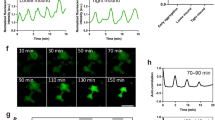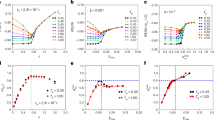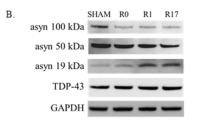Abstract
How sustained oscillations lose their periodicity and thus give rise to chaos was first analysed in mathematical models1–3, then observed in chemical systems such as the Belousov–Zhabotinsky reaction4,5 where chaos is autonomous because it originates from endogenous kinetic mechanisms. In contrast, chaos can also be obtained by periodically forcing an oscillatory system, as shown, for example, in cardiac cells6 and yeast glycolysis7. Biochemical evidence for autonomous chaos has been obtained both in vitro for the peroxidase reaction8 and in enzymatic models9,10 not based directly on experimental systems. We report here the occurrence of autonomous chaos in a realistic model for the cyclic AMP signalling system of the slime mould Dictyostelium discoideum11–13, based on receptor modification. This model14 is also capable of bursting, a phenomenon characteristic of some pacemaker neurones such as R15 in Aplysia15. Whereas bursting has not been observed in D. discoideum, our model suggests that ‘aperiodic signalling’16 in the mutant Fr17 provides the first example of autonomous chaos occurring spontaneously at the cellular level.
This is a preview of subscription content, access via your institution
Access options
Subscribe to this journal
Receive 51 print issues and online access
$199.00 per year
only $3.90 per issue
Buy this article
- Purchase on SpringerLink
- Instant access to full article PDF
Prices may be subject to local taxes which are calculated during checkout
Similar content being viewed by others
References
Lorenz, E. N. J. atmos. Sci. 20, 130–141 (1963).
May, R. Nature 261, 459–467 (1976).
Feigenbaum, M. J. J. statist. Phys. 19, 25–52 (1978).
Schmitz, R. A., Graziani, K. R. & Hudson, J. L. J. chem. Phys. 67, 3040–3044 (1977).
Roux, J. C. Physica 7 D, 57–68 (1983).
Guevara, M. R., Glass, L. & Shrier, A. Science 214, 1350–1353 (1981).
Markus, M., Kuschmitz, D. & Hess, B. FEBS Lett. 172, 235–238 (1984).
Olsen, L. F. & Degn, H. Nature 267, 177–178 (1977).
Decroly, O. & Goldbeter, A. Proc. natn. Acad. Sci. U.S.A. 79, 6917–6921 (1982).
Goldbeter, A. & Decroly, O. Am. J. Physiol. 245, R478–R483 (1983).
Gerisch, G. & Malchow, D. Adv. cyclic Nucleotide Res. 7, 49–68 (1976).
Newell, P. C. in Microbial Interactions: Receptors and Recognition Ser B, Vol. 3 (ed. Reissig, J. L.) 3–57 (Chapman & Hall, London, 1977).
Gerisch, G. A. Rev. Physiol. 44, 535–552 (1982).
Martiel, J. L. & Goldbeter, A. C. r. hebd. Séanc. Acad. Sci, Paris, Ser. III 298, 549–552 (1984).
Alving, B. O. J. gen. Physiol. 51, 29–45 (1968).
Durston, A. J. Devl Biol. 38, 308–319 (1974).
Shaffer, B. M. Adv. Morphogen. 2, 109–182 (1962).
Konijn, T. M., Van de Meene, J. G. C., Bonner, J. T. & Barkley, D. S. Proc. natn. Acad. Sci. U.S.A. 58, 1152–1154 (1967).
Alcantara, F. & Monk, M. J. gen. Microbiol. 85, 321–334 (1974).
Tomchik, K. J. & Devreotes, P. N. Science 212, 443–446 (1981).
Gerisch, G. & Wick, U. Biochem. biophys. Res. Commun. 65, 364–370 (1975).
Goldbeter, A. Nature 253, 540–542 (1975).
Goldbeter, A. & Caplan, S. R. A. Rev. Biophys. Bioengng 5, 449–476 (1976).
Goldbeter, A. & Segel, L. A. Proc. natn. Acad. Sci. U.S.A. 74, 1543–1547 (1977).
Goldbeter, A. & Segel, L. A. Differentiation 17, 127–135 (1980).
Roos, W., Scheidegger, C. & Gerisch, G. Nature 266, 259–261 (1977).
Theibert, A. & Devreotes, P. N. J. Cell Biol. 97, 173–177 (1983).
Stadel, J. M. et al. Proc. natn. Acad. Sci. U.S.A. 80, 3173–3177 (1983).
Springer, M. S., Goy, M. F. & Adler, J. Nature 280, 279–284 (1979).
Katz, B. & Thesleff, S. J. Physiol., Lond. 138, 63–80 (1957).
Heidmann, T. & Changeux, J. P. A. Rev. Biochem. 47, 317–357 (1978).
Lubs-Haukeness, J. & Klein, C. J. biol. Chem. 257, 12204–12208 (1982).
Devreotes, P. N. & Steck, T. L. J. Cell Biol. 80, 300–309 (1979).
Alamgir, M. & Epstein, I. R. J. Am. chem. Soc. 105, 2500–2501 (1983).
Coukell, M. B. & Chan, F. K. FEBS Lett. 110, 39–42 (1980).
Kessin, R. H. Cell 10, 703–708 (1977).
Mackey, M. C. & Glass, L. Science 197, 287–289 (1977).
Holden, A. V., Winlow, W. & Haydon, R. G. Biol. Cybern. 43, 169–173 (1982).
Darmon, M., Barra, J. & Brachet, P. J. Cell Sci. 31, 233–243 (1978).
Author information
Authors and Affiliations
Rights and permissions
About this article
Cite this article
Martiel, J., Goldbeter, A. Autonomous chaotic behaviour of the slime mould Dictyostelium discoideum predicted by a model for cyclic AMP signalling. Nature 313, 590–592 (1985). https://doi.org/10.1038/313590a0
Received:
Accepted:
Published:
Issue date:
DOI: https://doi.org/10.1038/313590a0
This article is cited by
-
Biology by numbers: mathematical modelling in developmental biology
Nature Reviews Genetics (2007)
-
Suppression of chaos by periodic oscillations in a model for cyclic AMP signalling inDictyostelium cells
Experientia (1992)
-
Regular oscillations in suspensions of a putatively chaotic mutant ofDictyostelium discoideum
Experientia (1989)
-
Parameter-dependent transitions and the optimal control of dynamical diseases
Bulletin of Mathematical Biology (1988)



